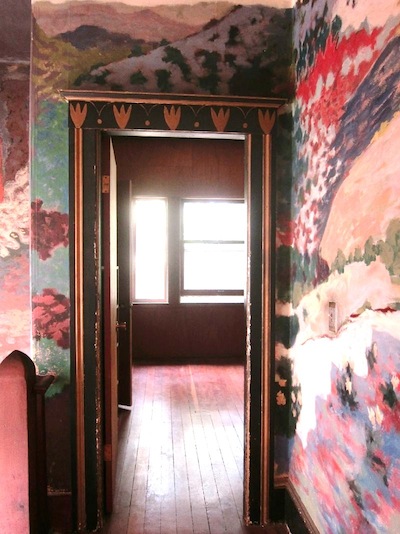In 1956, the artist Jess Collins returned to the Bay Area from Europe with his partner, poet Robert Duncan. He needed money, and Berkeley cineaste-cum-seamstress, cook and part-time copywriter Pauline Kael hired him to execute a series of murals on the walls of her brown-shingled home in Berkeley.
That was before all three had attained fame. Duncan ultimately established himself as one of the nation’s leading poets, and a founder of the San Francisco Renaissance. The Petaluma-born Kael, of course, reviewed movies for the New Yorker and became the most influential film critic of her generation. (Duncan and Kael were friends, having met at UC Berkeley in the 1930s.)
And Collins—who simply signed his work “Jess”—saw his reputation evolve from that of a quirky “outsider” artist to one of the West Coast’s most respected painters and collagists.
All three are gone now. But that 1905 house on Oregon Street remains, as do the stunning murals Collins created almost 60 ago. The home was purchased in the 1960s by Robert and Ann Basart; Robert was a composer, and Ann was a music librarian at Cal. The Basarts raised a family in the home, and in the fullness of time, Robert passed away and Ann required increasing care. Their children reached the inevitable decision: The house had to be sold.
And that’s causing considerable anxiety among art lovers. Any purchaser of the home—worth about $1.5 million in the current market, excluding the value of the art—could do whatever s/he wished with the murals. Drive nails through them to hang up portraits of the family dog. Paint over them. Tear down the house to build a McMansion.

“There are at least 10 panels, including several in the upstairs rooms that have been painted over but can be fully restored,” says Ortrun Niesar, a real estate agent with Sotheby’s, which is listing the property. “Everyone who sees them is just so charmed with them. They’re really spectacular. We’re desperately trying to put together an arrangement that will preserve the house—possibly by establishing a foundation, or finding investors willing to maintain it as a museum.”
Another possibility: Sotheby’s could put the house up for auction, attracting the attention of international art collectors. A far less attractive option: Removal of the murals prior to sale.
“It could be done,” acknowledges Niesar, who studied art history at Cal and worked at the Philadelphia Museum of Art and San Francisco’s Legion of Honor Museum. “But everyone involved in this, including the owners, would prefer that the murals stay where they are. The murals should not be considered as something separate from the house. They’re both connected, they speak to the power of Jess’ art, but also to the relationship he had with Robert Duncan and Pauline Kael, and the history of the San Francisco Renaissance.”

Christopher Wagstaff, a co-trustee of the Jess Collins Trust (which incorporates the estates of both Collins and Robert Duncan), called Collins a “great collagist and magnificent painter” who didn’t following the reigning vogues of the day.
“That may be why he was considered an ‘outsider’ artist for some time,” said Wagstaff. “He wasn’t really interested in pop art or abstract expressionism. He could paint in those styles, but they didn’t move him. He had tremendous depth and range. Among his peers he was noted as an artist’s artist, a painter’s painter.”
Collins was trained as a chemist, and was assigned to the Manhattan Project after he was drafted into the military during World War II. Following the war, he worked on the Hanford Atomic Energy Project in Richland, Washington, where he painted in his spare time. But a horrifying nightmare of an obliterated world caused him to reject a career in science in 1948, and he devoted himself wholly to art.
There is a certain stereotype of the aggressive self-promoting artist, but Jess was the utter opposite, says Wagstaff. “I knew Jess for 15 years, and he was incredibly kind, non-assertive and modest. He simply couldn’t abide self-promotion, he didn’t like crowds, and he didn’t go to parties. He didn’t even go to his own gallery openings. His art was everything to him. He worked extremely long hours, and when he wasn’t working, he was doing crossword puzzles.”
Like Niesar and the Basart family, Wagstaff feels Jess’s murals and the Oregon Street house must not be put asunder.
“Everyone involved with this wants the right thing to happen,” says Wagstaff. “But we’re at crucial point here—we need to find people or institutions to help us, and we need to find them very soon.”
A reception will be held at the former Kael residence tomorrow (July 10) at 4:00 pm. Attendance is by appointment. For information, call 510-326-2161.


















